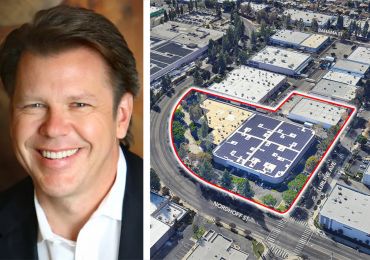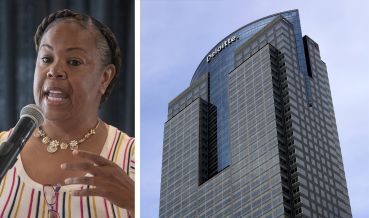Colliers’ Michael Cohen On Filling All That Empty New York Office Space
It all starts with rezoning vast swaths of the city and letting private capital come in
By David M. Levitt April 16, 2024 10:00 am
reprints
In the New York area, there are a handful of transcendent real estate brokerages: CBRE (CBRE), Cushman & Wakefield (CWK), JLL (JLL), Newmark (NMRK), Savills.
Colliers (CIGI) is one of them too. Those in high positions at any one of these firms have a special vantage point on New York and its health as an engine for nationwide business growth. Ignore their opinions on the city’s economic health at your own risk.
Therefore Michael Cohen’s viewpoint is an important one. Cohen, president of the global brokerage’s New York tri-state region, is almost never at a loss for words about that region and where it’s going.
Cohen, with some assistance from Colliers’ statistical guru Franklin Wallach, recently sat down with Commercial Observer to answer questions that have been on the minds of not only the real estate industry’s professionals but policymakers and other business leaders.
This interview has been edited for length and clarity.
Commercial Observer: How do you see Manhattan leasing its way back to 10 percent availability (it was 18 percent at the end of the first quarter, per Colliers data), and how long will that take?
Michael Cohen: So, I imagine you knew this when you asked the question: I don’t really see us leasing our way back to 10 percent, or anything near 10 percent. Improved leasing can reasonably be part of the equation, but it’s not the single factor.
So if 10 percent is not the new normal, what is the new normal?
Job growth alone, which has historically been the way we lease ourselves out of the troughs of the market cycle, is not going to be sufficient. We’re going to have to look for other ways to reduce the oversupply to a more manageable number, closer to that 10 percent equilibrium
In some places in this market, we’re already there, remarkably. The difference between Park and Sixth and Third and some of the other submarkets as of year end 2023 — Sixth Avenue and Park Avenue in the primary areas have an availability rate of between 11.5 and 12 percent, which is much closer to market equilibrium, whereas Third Avenue, Seventh Avenue and Broadway had availabilities in the 19- and 20-plus percentages.
So what you are saying is that we are seeing the areas along Park and Sixth race ahead while the rest of the city lags. Are you saying we’re going to have “have avenues” and “have-not avenues”? A bifurcation of the market? It would be nice if you had one part of town where everything is rosy and another where you could work on all sorts of conversion options.
I just want to clarify a couple of things regarding Park and Sixth. It’s not just their locations, which have always been appealing, as you have pointed out. There’s always been a tremendous amount of capital that has gone into them to make them more appealing to a 21st century audience. Also, the southern end around Bryant Park has also been a crossover market that is almost unique to Midtown, and that has appealed to the technology industry, anchored by the Salesforce Tower overlooking Bryant Park, which kind of gave the equivalent of the Salesforce seal of approval to that part of town.
And we’ve seen Indeed, Global Relay and a number of other technology clients focus on the Bryant Park neighborhood as distinguished from Sixth Avenue in general, and that has given Sixth Avenue a competitive advantage over other parts of Midtown.
The list of technology companies on Sixth also includes Take-Two Interactive at 1133 Avenue of the Americas, and then the other one is Array, and the one at 5 Bryant Park is Seamless-Grubhub. You don’t find technology companies in the Plaza District or on Park Avenue — that’s mostly financial services. But Sixth attracts finance and technology.
So the question still remains, how do we get from almost 100 million empty square feet or an availability rate of 18 percent, back to something closer to 10 percent, as we have on Park and Sixth? And the answer is a little of this and a little of that. It’s not monolithic.
You say it’s not monolithic, but a lot of it is going to be office-to-resi conversion. Give me your take on that.
Let’s start with the elephant in the room: residential conversion. We can all recall that once upon a time, resi conversion was what helped downtown with its oversupply. And we’ve already seen that phenomenon start again. It’s very robust. Frank, what was our total square footage count so far for confirmed residential conversions?
Franklin Wallach: When we did this a few weeks ago, I believe it was in the ballpark of 8 million square feet or so. But it’s a living document.
Cohen: There are many more that are unconfirmed. We hesitate to share that because it can stigmatize a building, and it could prove to be wrong.
The current 8 million, much of that is already taken out of inventory, though not all. What’s available is not almost 100 million minus 8 million. The most recent addition of 222 Broadway took half a million square feet off the market overnight. Sometimes they’re dribs and drabs. You just don’t know.
Seems the Adams administration has been going around saying we’re all about conversion. But I don’t know if the real estate establishment agrees that they’re doing everything they can to make conversions happen. As a member of the real estate establishment, what do you think? Do you think they could be doing more?
Cohen: Colliers doesn’t permit me to take political positions. I can answer your question, but not as to the Adams administration specifically. Before I answer, do we have a number for how much square feet is being readied for conversion?
Wallach: Yes, it’s a little over 16 million square feet — confirmed, most likely, rumored, wait and see. Residential conversion, conversion to hotel — all fall under that umbrella.
Cohen: To come back to the question, legislation that is going to automate this process is going to be a big boost. That includes rezoning Midtown South. The city speaks to the elimination of these anachronistic manufacturing zones in that area that are really brimming these days with hospitality and retail and residential and office, and are not hospitable to manufacturing.
I’m going to switch hats here for a moment and be a bit of a booster because, as you may know, I chair the business improvement district known as Flatiron-NoMad, and we consider our neighborhood the poster child for the city of the future. The epicenter of Flatiron-NoMad is Madison Square Park. If you look in all directions around the park, you find the live-work-play environment that is so desirable.
And, to the north and the west of us, there are parts of town that cannot be put to their highest and best use under the current zoning. And the city is well underway soliciting public comment and planning to complete the public review and approval process by 2026. That’s going to open up millions of square feet for redevelopment into residential, both conversions and new construction. And I think there is tremendous demand for that. It’s long overdue.
Seems what you are saying is we can rezone our way out of the problem, and market forces will eventually take care of it.
That is precisely it. You restated it beautifully. It’s not just the rezoning of Midtown South, but also initiatives that allow the creation of residential space to become easier.
I’m not a zoning lawyer, but I will cite my favorite example. This is part of what the Adams administration calls the City of Yes. All my professional career, the mix of commercial and residential had to be such that the commercial was below the residential. So the base of the building could be office and the tower residential — for reasons I never questioned or understood. You can’t mix it. If the 11th floor is residential, the 12th floor can’t be commercial But that distinction is proposed for elimination now. I don’t know what the justification was. Maybe there was one once upon a time.
That’s my favorite example of the kind of outdated limitations that are proposed for elimination.
I think that the city is going to see a metamorphosis as this plays out. There continues to be demand from people that want to live here, and the market will take advantage of that.
The third thing to consider is teardowns, which may result in more desirable office buildings, or hotels or hospitality — the use is not preordained. We’ve emptied out a building in the Plaza District. SL Green (SLG) had 625 Madison, ours is a stone’s throw away at 655 Madison. We’re going to see those buildings get torn down and replaced probably by a mixture of retail, hospitality, and residential. And I don’t have to tell you that all three of those uses are very desirable in the Plaza District.
I have a theory that I haven’t heard anybody else share, which I will share with you. The city has, for a long time, had very little new development. In the real estate business, a modern building was one that was built in the 1980s or 1990s. There was very little in the wake of the 2001 meltdown, very little construction in the 21st century. And part of the problem was that in the most desirable neighborhoods along Park and Madison and so forth, if you tore down a building, you couldn’t even rebuild what you tore down. So intrepid developers like L&L Holding came up with workarounds.
So we had this inability to create new product due to this anachronistic zoning. L&L used these workarounds, but they were not as satisfying as tearing down an old building and replacing it with a new one. So Hudson Yards was born, I believe, off the overflow of tenants who could not find the large modern new buildings that they needed in Midtown.
Simultaneous with Hudson Yards, the city did an experiment with rezoning to allow buildings as large as One Vanderbilt, which proved hugely popular.
The city rezoned the site and allowed SL Green to purchase air rights. In return, the city got transit improvements, and this became a template for the Midtown East rezoning. This resulted in a modern building right in the heart of Midtown.
And, in the wake of One Vanderbilt, the city changed the zoning, so the air rights to St. Patrick’s and Grand Central are fungible over a large swath of Midtown East.
The poster child for this, I always say, is 250 Park, which is in a fabulous location and is being offered for sale right now. It’s a building that has a demolition clause in it. I guarantee you, every buyer looking at that building is looking at it as a development site. It will eventually be torn down and replaced by a supertall.
Look for a moment at the other end of the market — the market for Class B and Class C product. I get the sense that you guys actually see a market for that that might not be visible to the general public.
There’s no question that the B product is getting an unnecessarily bad rap. What people fail to understand is that within the B product category there are gradations. And there is a flight to quality. So, you can be a highly successful B building in this market if you are well positioned, well priced and well financed — and well thought out as property. I think we saw some disproportionate leasing in the B category already this year.
Wallach: There was just under 2 million square feet of leasing activity in the Class B product in the fourth quarter of 2023, which was the highest single quarter of Class B leasing activity in two years. And, as far as notable transactions that took place in 2023 and early 2024, you had Ralph Lauren Polo with their renewal at 601 West 26th Street; then you had Michael Kors this year, at 11 West 42nd. You had David Yurman with 154,000 square feet of renewal and expansion at 200 Hudson Street.
You might call these kinds of users “cool.” They’re in fashion, one of the creative industries. Is that a trend?
Cohen: What I would say to you is — and I’m wearing my Flatiron-NoMad hat now — our market is full of former department stores, cast-iron buildings, buildings with architectural cachet, that attract creative tenants. You can’t build a 21st century cast-iron building, or an architecturally distinctive Ladies Mile department store. That inventory can’t increase, and the demand for it from the creative sector has not gone away.
Some of these buildings have amenities built into them now. Some of them have the amenities next door, down the block. Do you need to have a barista on the ground floor when Mangia is next door? These neighborhoods and their architectural cachet cannot be replicated.
CORRECTION: This article was updated to reflect the correct addresses for 222 Broadway and 601 West 26th Street.



